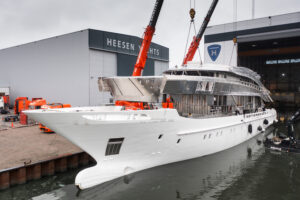Lithium-ion batteries contributed to 2021’s fire on MY Siempre

Malta’s Marine Safety Investigation Unit (MSIU) has released its report into the fire onboard MY Siempre. The fire occurred in September 2021, whilst MY Siempre was moored at the port of Olbia, Italy.
MSIU’s report says that it can’t exclude the fact that the li-ion batteries on board were either the cause of the fire, and / or a contributing factor to the intensity and spread of the fire. Neither can it exclude the possibility that the fire may have started due to a short circuit in the electrical power socket of the yacht’s water scooter.
The report details the toys that the yacht was carrying. These included an electric water scooter, two electric surfboards, an electric hydrofoil surfboard, two electric underwater scooters, two electric scooters and two electric bicycles. It also stresses that an old (dead) battery of the hydrofoil surfboard was stowed in a locker. The fire broke out on the open aft deck, where the yacht’s toys were mainly stored. The crew – awoken by a fire alarm – jumped into the water.
The crew stated that, in accordance with on board procedures, no leisure equipment was left to recharge unattended and / or overnight. They also stated that all equipment had last been used by the yacht’s last charter guests on 02 September 2021, following which, the deckhand and the chief stewardess recharged and unplugged them later that same evening. They confirmed that no equipment was being recharged during the night of the accident.

Cause of the fire
MSIU hypothesises that, based on the information provided to the safety investigation and noting that the crew members of a neighbouring yacht had noticed the fire developing in the vicinity of the water scooter, the fire may have been caused either by the dead li-ion battery of the electric hydrofoil surfboard, which was stored in the starboard locker, or by one / both electric surfboards’ li-ion batteries which were stored below the water scooter. In the case of the electric surfboards’ batteries, it would have meant that one / both developed a fault during the last use, which had gone unnoticed by the crew members.


Since the exact seat of the fire could not be established, the safety investigation did not exclude a third possibility that the fire may have been caused by an electrical short circuit in the charging socket of Siempre’s water scooter. In its consideration, MSIU considered that about two weeks prior to the fire, a power socket had malfunctioned.
That said, the amount of time spent to fight the fire, and the flames and smoke that continued to emerge over the following couple of days (even with the yacht partially submerged) could have been likely due to the thermal runaway process and subsequent reignition of the several li-ion batteries onboard, says MSIU.
MSIU has issued two recommendations designed to ensure that yacht crew members are made aware of the hazards posed by lithium-ion batteries and are guided on proper handling and disposal procedures for these batteries.
Insurance refusals on lithium-ion boats
Lithium-ion batteries have been the cause of, and charged with, several notable marine fires in recent years. And now there’s talk of insurance companies refusing to cover boats in the UK. In June 2022, MIN advised boat owners to check their polices and speak to their insurance brokers, especially if they’re thinking of retrofitting lithium-ion powered engines.

MY Siempre narrative
On 6 September 2021, at 1.28am, the CCTV camera captured smoke escaping from Siempre’s aft deck, soon followed by intermittent bright flashes, resembling open flames. This caught the attention of the crew members of a neighbouring yacht (MY Blue Vision), who were on the dock at that time.
On approaching to have a closer look, they noticed a fire developing in the vicinity of Siempre’s water scooter, which was housed on the aft deck.
They stated that the fire soon spread across the aft deck and that they observed that within seconds, the flames reached a height of between 2m and 2.5m.
At 1.30am, one of Blue Vision’s crew members reported the fire to the master and chief officer. The chief officer rushed ashore and telephoned the emergency services of the port.
In the meantime, the crew of Siempre, who were asleep in the cabins, was alerted by the yacht’s fire alarm. The chief engineer ran up the interior stairway to investigate and, on reaching the saloon on the main deck, he observed a large fire on the aft deck. He ran back to the crew’s accommodation and instructed the rest of the crew members to vacate the accommodation area through the escape hatches on the yacht’s bow.
The chief engineer then connected a fire hose and started the fire pump from the bridge to
extinguish the fire.
At 1.36am, on seeing Siempre’s crew members on the bow, the master of Blue Vision instructed his chief officer and deckhand to take their tender boat to Siempre’s bow to assist in the evacuation of the crew members.
The tender boat was by Siempre’s bow after three minutes and stood by for the evacuation. During this time, the crew members of Yacht B were also alerted of the fire. They unmoored their yacht and immediately manoeuvred it away from Siempre. At 1.39am, the crew members of Yacht A started their fire pump and directed their fire hoses toward Siempre.
Meanwhile, while the chief engineer continued with his attempts to extinguish the fire, the fire raged on Siempre’s aft deck, also reaching the water scooter and tender boat.
At around 1.50am, a shore fire brigade arrived and joined in the fire fighting. By this time, observers noticed that the fire had spread and reached the bridge deck. Moments later, all four crew members of Siempre jumped into the water from the bow. They were picked up by Blue Vision’s tender boat and brought safely to the pier beside Blue Vision, at 1.55am. The crew members of Blue Vision recalled that Siempre was completely engulfed by the fire by 2.30am. At 3.46am, the flames were seen to be receding.
The shore fire brigade continued to fight the remaining flames, using water and foam. Subsequently, Siempre started to develop a port list. At around 7.30am, while the shore fire brigade was still fighting the fire, Siempre listed over to its port side. However, for the following two days, several interventions were still required by the shore fire brigade to tackle emerging flames and smoke from parts of the yacht that were above the water level.
Superyacht fires
There have been several destructive fires on yachts and in marinas this summer. A massive marina fire destroyed four yachts on the Greek island of Corfu on 7 September, with people on the nearby dock working to tow vessels away from the blaze.
In August, five people were rescued from a fire on the experimental Swiss yacht Porrima, after a blaze broke out in the battery compartment off the coast of India. A brand new ISA superyacht Aria SF was engulfed by fire while cruising off the coast of Formentera in Spain. And, in late July, a 27-metre Pershing 88 superyacht caught fire off the coast of Positano, Italy, in late July.
Images of yacht fire courtesy of Vigili del Fuoco. Other images from MSIU report.












What a nightmare. Always be careful with batteries. I store all my batteries in fireproof cases: https://e-surfer.com/en/shop/efoil/esurfboard-battery-box-m/
They take space and they are not inexpensive, but can save your yacht.
Really misleading regarding battery technology.
Fails to declare which LiPO technology was involved or even present.
The technologies are so massively different.
LIFePO4 is very very safe – LiCoO2 is not ( it’s what’s inside mobile phones)
LIFePO4 should not be thought of in the same way as other Lithium Ion batteries they simply don’t have the same characteristics.
Lithium manganese oxide (LiMn2O4); aka: IMR, LMO, Li-manganese
Lithium manganese nickel (LiNiMnCoO2); aka INR, NMC
Lithium nickel cobalt aluminum oxide (LiNiCoAlO2); aka NCA, Li-aluminum
Lithium nickel cobalt oxide (LiCoO2); aka NCO
Lithium cobalt oxide (LiCoO2); aka ICR, LCO, Li-cobalt
Lithium iron phosphate (LiFePO4); aka IFR, LFP, Li-phosphate